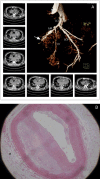Diagnosis of coronary artery disease using targeted post-mortem computed tomography coronary angiography: a case report
- PMID: 30483627
- PMCID: PMC6197108
- DOI: 10.1080/20961790.2017.1328795
Diagnosis of coronary artery disease using targeted post-mortem computed tomography coronary angiography: a case report
Abstract
Targeted post-mortem computed tomography (PMCT) combined with coronary angiography has the potential to play a significant role in the investigation of sudden cardiac death. The authors utilized a targeted PMCT coronary angiography in a case involving a 53-year-old man who died from acute myocardial ischemia and cardiac decompensation which may result from coronary artery disease (CAD). The victim collapsed suddenly at work and died soon after arrival to hospital. The body was examined using PMCT and targeted PMCT coronary angiography. The left anterior descending coronary artery exhibited 75%-100% stenosis in the middle segment; however, the distal segment could not be clearly visualized. In addition, the left circumflex and right coronary artery exhibited calcification, atherosclerosis and an area of 50% stenosis. Signs of cardiogenic pulmonary oedema were also identified. The imaging results suggested that this individual had coronary atherosclerosis and probably died from CAD. The autopsy and histological examination revealed acute myocardial ischemia and myocardial scarring, confirming the cause of death while excluding other probabilities. In summary, targeted post-mortem computed tomography angiography (PMCTA) can visualize the arteries and estimate the degree of principal pathological changes. This method is a simple, reliable and sensitive technique for identifying the presence of coronary atherosclerosis. It is a valuable post-mortem forensic imaging method and should be recommended in the investigation of suspicious cardiac deaths.
Keywords: Forensic science; PMCT; PMCTA; coronary atherosclerosis; forensic pathology; post-mortem forensic imaging; targeted coronary angiography.
Figures



Similar articles
-
The value of PMCTA in the diagnosis of coronary atherosclerosis in isolated human hearts.Forensic Sci Res. 2024 Jan 17;8(4):308-312. doi: 10.1093/fsr/owad038. eCollection 2023 Dec. Forensic Sci Res. 2024. PMID: 38405630 Free PMC article.
-
Correlation and assessment of coronary artery luminal stenosis: Post-mortem computed tomography angiogram versus histopathology.Forensic Sci Int. 2020 Mar;308:110171. doi: 10.1016/j.forsciint.2020.110171. Epub 2020 Jan 28. Forensic Sci Int. 2020. PMID: 32032870
-
The effect of post-mortem computed tomography angiography (PMCTA) on biomarkers of coronary artery disease.J Forensic Leg Med. 2024 Feb;102:102654. doi: 10.1016/j.jflm.2024.102654. Epub 2024 Feb 1. J Forensic Leg Med. 2024. PMID: 38310784
-
Evolution of post-mortem coronary imaging: from selective coronary arteriography to post-mortem CT-angiography and beyond.Radiol Med. 2018 May;123(5):351-358. doi: 10.1007/s11547-018-0855-x. Epub 2018 Jan 22. Radiol Med. 2018. PMID: 29357039 Review.
-
Impact of the COVID-19 pandemic on a post-mortem CT service for adult non-suspicious death.Clin Radiol. 2023 Nov;78(11):822-831. doi: 10.1016/j.crad.2023.03.013. Epub 2023 Aug 14. Clin Radiol. 2023. PMID: 37827592 Review.
Cited by
-
The value of PMCTA in the diagnosis of coronary atherosclerosis in isolated human hearts.Forensic Sci Res. 2024 Jan 17;8(4):308-312. doi: 10.1093/fsr/owad038. eCollection 2023 Dec. Forensic Sci Res. 2024. PMID: 38405630 Free PMC article.
-
State of the Art on the Role of Postmortem Computed Tomography Angiography and Magnetic Resonance Imaging in the Diagnosis of Cardiac Causes of Death: A Narrative Review.Tomography. 2022 Apr 1;8(2):961-973. doi: 10.3390/tomography8020077. Tomography. 2022. PMID: 35448711 Free PMC article. Review.
-
Assessment of Myocardial Ischemia Using Coronary Postmortem Computed Tomography Angiography Based on the Voronoi Algorithm: A Case Report.Cureus. 2024 Jul 15;16(7):e64565. doi: 10.7759/cureus.64565. eCollection 2024 Jul. Cureus. 2024. PMID: 39144873 Free PMC article.
-
Bleeding-Source Exploration in Subdural Hematoma: Observational Study on the Usefulness of Postmortem Computed Tomography Angiography.Diagnostics (Basel). 2023 Jul 6;13(13):2286. doi: 10.3390/diagnostics13132286. Diagnostics (Basel). 2023. PMID: 37443680 Free PMC article.
-
Diagnosis of drowning using postmortem computed tomography combined with endoscopic autopsy: A case report.Medicine (Baltimore). 2020 Mar;99(11):e19182. doi: 10.1097/MD.0000000000019182. Medicine (Baltimore). 2020. PMID: 32176043 Free PMC article.
References
-
- DiMaio D, DiMaio D. Deaths due to natural disease. Forensic Pathol. 2001;2:57–58.
-
- Roberts IS, Benamore RE, Peebles C, et al. . Diagnosis of coronary artery disease using minimally invasive autopsy: evaluation of a novel method of post-mortem coronary CT angiography. Clin Radiol. 2011;66:645–650. - PubMed
-
- Saunders SL, Morgan B, Raj V, et al. . Targeted post-mortem computed tomography cardiac angiography: proof of concept. Int J Legal Med. 2011;125:609–616. - PubMed
-
- Morgan B, Biggs MJ, Barber J, et al. . Accuracy of targeted post-mortem computed tomography coronary angiography compared to assessment of serial histological sections. Int J Legal Med. 2013;127:809–817. - PubMed
-
- Rutty G, Saunders S, Morgan B, et al. . Targeted cardiac post-mortem computed tomography angiography: a pictorial review. Forensic Sci Med Pathol. 2012;8:40–47. - PubMed
Publication types
LinkOut - more resources
Full Text Sources
Miscellaneous

